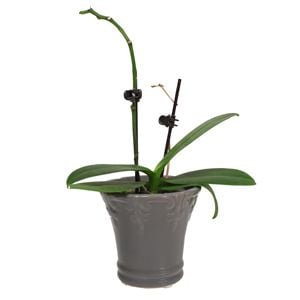
Think of the onset of spring, under mounds and mounds of snow, out pops the head of a bright yellow daffodil.
Caring for a dormant, resting Phalaenopsis orchid can be similar to that daffodil: You’re watching a bare stalk and leaves for a few months in hopes the plant will reward you with another round of bright, beautiful blooms, and when it does, you feel a thrill similar to the first signs of spring.
Sometimes, though, despite your best efforts, your Phalaenopsis orchid isn’t blooming on the timetable you expected. Consider these reasons why your orchid may still be resting.
After your orchid’s flowers fall, you’re left with a bare spike that will eventually turn brown. And while it doesn’t harm the plant, the bare spike does take away some of the energy the plant needs to rebloom. (Remember, just like every other living thing, orchids need to rest and restore their energy, too.) If you haven’t cut the bare spike and it has turned brown, use sterilized scissors or another tool to trim the spike 1 inch from the base of the plant. This will allow the orchid to put more energy back into the leaves and roots to help it grow stronger and produce a fresh new spike.
Winter is a common dormant period for Phalaenopsis orchids, and along with the cold, winter also brings drier air. This dry air may be a reason your orchid is still bare. Try increasing the moisture around your plant by creating a humidity tray. Take a shallow decorative tray, add some water and decorative stones or glass beads, and put your orchid on top. Misting your orchid with water from a spray bottle or using a humidifier also can help keep things moist.
This point might seem contradictory, given that orchids thrive in warm temperatures. But in their native environment, the sharp drop in nighttime temperature helps trigger reblooming. Orchids enjoy temperatures most humans do—between 65 and 80 degrees—but can benefit from a nighttime temperature of 55 degrees. That temperature is a little chilly for most of us, especially during the winter, so it’s recommended you move your orchid to a naturally cooler spot in your home during the overnight hours. Basements are usually cooler than the rest of the home, so you might try placing your orchid there for the night or if you have a room that’s cooler than the others, try placing it there.

Copyright Just Add Ice® Orchids 2023